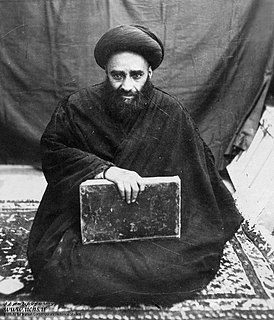
Mohammad Kazem Khorasani or Akhund-e Khorasani was Twelver Shi'a Marja, politician, philosopher, reformer. He's regarded as one of the most important Shia Mujtahid at the time. He was a lecturer at Najaf seminary for years and significant number of students from "different regions of the Muslim world" used to participate his lectures. His most famous work is The Sufficiency where he gathered the jurispurdential ideas such as `continuity` and "presented them in a yet more rigorous fashion as a unified theory of jurisprudence."

Grand Ayatollah Mohammad Taqi Bahjat Foumani was an Iranian Twelver Shia Marja'.

Grand Ayatollah Mohammad Reza Golpaygani was an Iranian Shia Islam cleric and marja. He was born in Gogad village, near the city of Golpaygan, Iran. He was taught preliminary studies by his father, Mohammad Bagher. At the age of 9, his father died, and he moved to Golpaygan to continue his studies. At the age of 20, he moved to Arak to study under Abdul-Karim Ha'eri Yazdi. After Ha'eri Yazdi and Ayatollah Mohammad Taghi Khansari founded the hawza of Qom, he moved there and delivered lectures in the Islamic Seminary. He was one of the highest-ranking Islamic clergy to participate in the Islamic Revolution of 1979, and a one-time serious contender to succeed Ruhollah Khomeini as the Supreme Leader of Iran in 1989. However, his candidacy was voted down by the Assembly of Experts, in favor of the eventual successor and current leader, Ali Khamenei.
Kitab al-Makasib or Makasib is a two-volume Twelver Shi'ah legal manual of Islamic commercial law written on Fiqh by Morteza Ansari. It remains a key textbook in the modern Hawza and has been the subject of numerous commentaries. Makasib and the notable work of Akhund Khorasani, Kefayah al-osul, are taught in advanced classes at the seminaries. This book is one of the resources for the examination of the Assembly of Experts.

Abu l-Hasan al-Isfahani was a Shia scholar and Marja'.

The Qom Seminary is the largest Islamic seminary (hawza) in Iran, established in 1922 by Grand Ayatollah Abdul-Karim Haeri Yazdi in Qom.

Ali Tabatabai, also known as "Allamah Qadi", was an Iranian alim and mystic. He was the son of Husseyn and was born in Tabriz, Iran. He was born on 29 April 1866 in Tabriz. his father Sayyed Hosein Qazi was a prominent pupil of The grand Mirza Shirazi. His maternal grandfather, Mirza Mohsen, was a great jurist.

Ayatollah Sayyed Razi Shirazi is a jurist, philosopher and theologian. He is currently the Imam of the Shifa mosque in Yousef Abad, Tehran.

Muhammad Taqi Amoli (1887-1971) was an Iranian Shiite jurist, philosopher and mystic.
Allameh Abul Hasan Sharani was An Iranian philosopher, jurist and theologian. He was one of the great teachers of the philosophical school of Tehran
Mirza Mahdi Ashtiani (1888–1952) Man of wisdom, Mystic, Man of Literature, was A Great Master in the philosophical School of Tehran.

Mirza Mahdi Elahi Qomshehei was an Iranian mystic, poet, translator of the Quran, and also one of the grand Masters of the philosophical school of Tehran.

Sayyed Muhammad Hojjat KouhKamre'i was a Shia jurist and scholar in the principles of Islamic jurisprudence, hadith studies and narration studies. He was a Grand Ayatollah (marja') among Shia and founded the Hojjatiyyah School in Qom.
Ibn Fahd Helli was an eminent Shia jurist and religious scientist in the eighth and ninth Hijrah lunar.
Mirza Agha Ibrahim Estahbanati Shirazi was a Shia Islam Jurist and religious scholar in Iran.
Sayyed Muhammad Tabatabei Fesharaki was an eminent shia jurist in 13th Lunar Hijrah. He was considered as Master of eminent religious scholars such as Muhammad Hosein Na'ini and Abdul-Karim Ha'eri Yazdi, the founder of Qom Seminary.
Abdallah Mazandarani was a Shia Marja' and a leader of the constitutional movement against the Qajar dynasty. He was a pupil of Mirzaye Rashti.
Fethullah Qa'ravi Isfahani Child of Mohammad Javad Namazi the marja who was born in 1850 in Isfahan. After the death of Muhammad Taqi Shirazi, and in general the authority of the German Empire led an uprising against the Iraqi people in Great Britain continued.

Sayyid Mohammed Hassan Husayni Nouri Shirazi, commonly known as Mirza Shirazi, was an Iranian Shia marja'. He is known for his 1891 verdict against the usage of tobacco in what became known as the Tobacco Protest in the Qajar era.



















